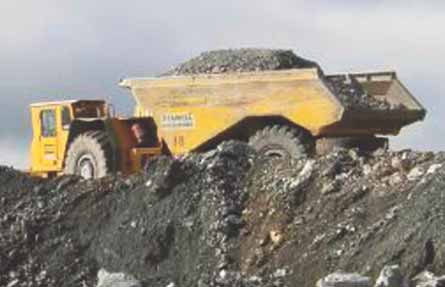
Atlas Copco’s Minetruck MT6020 on test in Australia.
Nordic Mining Equipment: Innovation Plus Dedication
This means coupling product manufacturing and the distribution network with a service operation and training capability and then maintaining the quality of that operation in each and every market—not easy. The ongoing high level of demand worldwide in 2006 and 2007 has encouraged the region’s technology suppliers to rethink operating strategies and organizational structures at the same time as encouraging and assisting them to continue investing in research and product development.
Atlas Copco, Productivity Solutions Provider
The Atlas Copco group serves more than
150 markets worldwide and employed
25,900 people in 2006, earning revenues
of €5.6 billion and achieving an
operating margin of 18.2%. This margin
was well ahead of the 14.6% average
for the previous five years, during
which time compound growth averaged
about 14% excluding currency translation
effects. In July 2007, the group
reported that April–June had been Atlas
Copco’s best quarter ever, with a 30%
rise in operating profit taking it above
SEK3 billion (€328 million) for the first
time. This corresponded to a margin of
19%. The group aims to become and
remain First in Mind—First in Choice
and, anticipating further demand
growth, has decided to invest in production
capacity expansions for both
the Compressor Technique and
Construction & Mining Technique
(CMT) business areas.
While the CMT product managers were able to show a wide range of new equipment at bauma, a particular development thrust during the past two years has been to enhance the loading and haulage product lines built in Örebro, Sweden. This was in evidence at AIMEX in September, where Atlas Copco launched the new 60-mt capacity Minetruck MT6020 following successful trials at the Stawell gold mine in Victoria, which already operates MT5010 trucks. Mark Smith and Kjell Fjordell, respectively product managers for large loaders and mine trucks, explained that one area of attention for both types of vehicle has been the power train.

Consequently, the MT6020 can achieve unloaded speeds of 37 km/h on the flat and 27.7 km/h on a 10% grade in sixth gear, and can climb a 20% grade at 15.3 km/h in fourth, assuming 3% rolling resistance. Loaded, the truck should climb a 2% grade at 31 km/h in sixth and a 20% grade at 6.9 km/h in second gear. The MT6020 also has a fast-dumping box design (dumping time is 15 seconds) and large highspec operator’s compartment. Turning angle is +/- 42.5°, recommended drift size is 5,500 mm wide by 5,000 mm high, and the SAE heaped volume of the standard dump box with 2 mt/m3 material is 32.8 m3.
The newest Scooptram design, the 14-mt-capacity ST-14, has a Tier 3 compliant Cummins engine, said Smith; in this case, a QSM11 rated 250 kW (335 hp) at 2,100 rpm and delivering maximum torque of 1,674 Nm at 1,350 rpm. The ST14 has a Superior upbox, Dana Series T40 000 automatic powershift transmission with integrated converter, and Dana 53R full floating axles. With empty bucket and assuming 3% rolling resistance, speeds in fourth gear range from 28.5 km/h on the level to 8.6 km/h on an 8.3% grade while in second gear the LHD can climb a 30% grade. Fully loaded fourth gear speeds range from 26.3 km/h at 0% to 6.7 km/h at 6%. In first the fully loaded machine can climb a 30% grade at 3 km/h. Breakout force is 22,300 kg hydraulic and 18,240 kg mechanical and the standard bucket is a 6.4 m3 unit (nominal, heaped). The Rexrothbased load-sensing hydraulics enable boom raising in 7.6 sec, lowering in 3 sec and dumping in 1.8 sec. There is a radio remote control interface and Atlas Copco’s Scooptram RRC line of sight radio remote control is an option.
The manufacturer completed development of a matched low-profile Scooptram and MInetruck during the year, the ST1030LP and the MT436LP. At 1.84-m high the ST1030LP is 51 cm lower than the standard ST1030 and the biggest design challenge was making the cab comfortable, said Johan Kemppi, who oversaw the Scooptram’s development. The MT436LP is 2.3-m high and, according to designer and project leader Karin Stiernstedt, key changes from the standard MT436B include a forward-mounted camera to enhance visibility from the low profile cab, easier maintenance and a lower, wider rock box. Both the low-profile and standard Scooptram ST1030 have Cummins QSL9 engines that are Tier 3 compliant and there is also an electric drive version. And, early in 2007, Atlas Copco announced the replacement of the Minetruck MT2000 with the MT2010 also featuring a QSK9 engine (E&MJ, April 2007, p.98). Further developments are in the pipeline.
For the underground drilling market Atlas Copco has focused primarily on the new Rocket Boomer E Series face drilling rigs for mine development and tunneling, exhibiting the XE3 at bauma (E&MJ, April 2007, p. 52). The firm also introduced the Rocket Boomer S1 D, which has been field tested at the Las Cenizas copper mine in Chile, and in July announced a new rock drill, the COP 2238 (see Equipment Gallery, p. 86).
Discussing established machines, product manager Patrik Ericsson said that the Cabletec cable bolting rig had gained ground in the market. The first machine, which is working at Outokumpu’s Kemi mine in Finland where it was first tested in 2003 and then purchased, has been followed by rigs delivered to Michilla in Chile, AngloGold Ashanti in Brazil, Placer Dome in South Africa (although this machine has not been used yet), Tara in Ireland, Zinkgruvan in Sweden, Otjihase in Namibia (which also has a Scaletec), and Bergteamet who recently started using it at LKAB Malmberget. Another Cabletec LC is in transit to AngloGold Ashanti in Brazil and one for Boliden’s Garpenberg mine was due to be shipped at the time of writing. The Cabletec is based on the Simba M7 production drilling rig with a second boom added for grouting and cable insertion. Ericsson said the Simba’s Rig Control System enables the operator to concentrate on grouting and cable insertion while the rig autonomously drills the next hole and extracts the drill string. This two-handed system significantly reduces the cycle time for bolting.
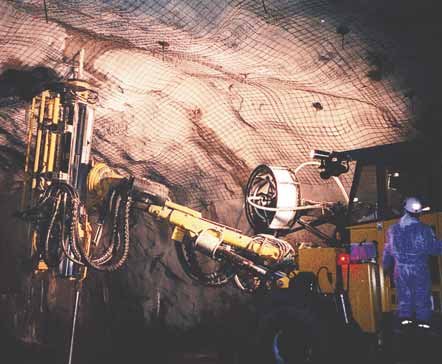
The SmartRig has recently passed the 100-delivered mark since the technology was introduced and the latest version with Atlas Copco’s GPS location system linked into the Rig Control System has now been successfully used not only in drilling complex roadbed profiles but also in quarrying limestone for ground calcium carbonate production— an Omya operation 400 km north of Trondheim in Norway recently started using a SmartRig with Measure-While- Drilling technology to improve product quality control. Presently available for tophammer drilling, SmartRig technology will be fitted to DTH machines in the future, especially perhaps for grade control drilling where greater accuracy is advantageous. Meanwhile Atlas Copco has just announced a replacement for the bestselling COP 1238. The 12-kW COP 1240 is specifically designed for surface drilling applications.
Secoroc, Atlas Copco’s drill tools unit, displayed the Magnum SR system for drifting and tunneling at bauma as well as the water-cooled Aqua 60 DTH hammer that features non-metallic wear bands and requires no oil, so offering a significant advantage for water well drilling. Slot drilling development is in the Mines section of this Nordic Focus—see pp. 51-52.
Sandvik: One Color, One Number
Sandvik is the Nordic region’s broadest
range supplier of mining, rock processing
and materials handling equipment.
The business is well-distributed
through world markets, the technology
is accepted and R&D spending is substantial,
and invoiced sales have grown
from SEK10.2 billion (€1.1 billion) in
2000 to SEK25 billion (€2.7 billion) in
2006. Roughly 50% of its business is
in mining equipment, 35% is with the
construction industry and 15% is in
material handling equipment and systems.
So the garden is pretty rosy, one
would think.Nevertheless, the company
has put a great deal of effort into
attempts to optimize its relationships
with a diverse and far-flung customer
base.
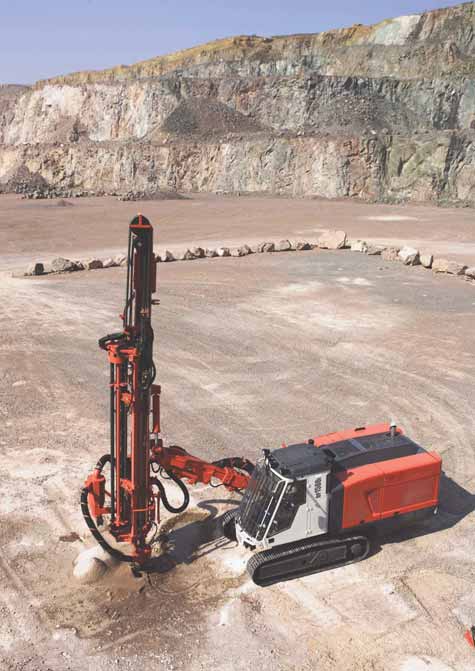
At bauma in April of this year, Sandvik introduced the new color and product design as well as the new product denominations. Sandvik Mining & Construction President Lars Josefsson and Marketing Director Magnus Titus explained the company’s strategy for the future (E&MJ, June 2007, pp. 73- 74). Josefsson identified the importance of logistic and supplies capability in providing customers with sales, service, customer relations and contact. So the message is: “On every site our objective is the same: to make our customer as productive and profitable as possible: we are dedicated to becoming a customer performance vendor, preferably the solution partner of choice.” So far formal partnerships are few in number but widely distributed (Canada, South Africa, Finland) and, if the one at Pyhäsalmi (E&MJ, September 2007, pp. 44–53) is typical, rather effective.
Main mining equipment launches at bauma were a new member of the intelligent tunneling jumbo series introduced at Intermat last year and the first in new series of surface tophammer drill rigs. The new Sandvik DT1130i is a three-boom jumbo for drilling 20- to 183-m2 cross sections. The new series combines precision and power with an advanced user-friendly working environment and many practical intelligence features, said Sandvik. Described as revolutionary (and Sandvik didn’t mean the rotation) the Sandvik DP1500i offers advanced, practical features that put the latest technology to serve drill owners and operators alike. This is the first machine in a new DPi Series based on the Pantera family but with added “smart technology,” said Sandvik.
Sandvik also introduced an advanced training concept it says will fundamentally change operator training. It will offer a safe and efficient way of learning practical work and significantly improve productivity.
Underground Soft Rock Mining
When E&MJ recently visited Sandvik
Mining & Construction GmbH at
Zeltweg in Austria, which is a product
company for the UG Soft Rock Mining
(USM) segment, Marketing Communications
Manager Hanno Bertignoll
explained how the reloaded matrix
works for this segment.
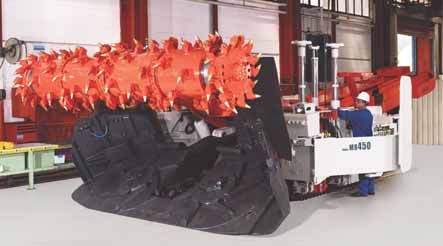
Zeltweg, which has operated in the mining and construction industry for more than 40 years, manufactures the roadheader, continuous miner, bolter miner, borer miner, special bolting platform and shuttle car ranges for coal and soft rock, plus hard rock miners, reef miner, boxhole borer and cutting attachments for the UG Hard Rock Mining and Construction segments. It is also Sandvik’s Competence Center for Mechanical Cutting and assembles the TITON range of surface drilling rigs for the Surface Mining segment. Redhead, 20 km south of Newcastle, New South Wales, supplies bolting rigs and mobile bolters. And Tychy, south of Katowice in Poland, produces the MR120 roadheader and a tracked loader and assembles the MR 300 roadheader for the Polish market. The factories at Tomago, Australia, and Burlington, Canada, build shield haulers, shield trailers, coal loaders and QDS attachments. And Bristol in the United States, Krugersdorp in South Africa and Newcastle in Australia supply cutting tools and drilling tools.
The current product range also includes automation technology and geotechnical services and customer support. The automation products include remote control and access systems, monitoring and reporting systems, automation, directional control/ navigation, onboard support and electronic manuals. USM is also developing new technologies, Bertignoll pointed out, including new continuous miner models, a roof-mounted continuous haulage system, a new underground conveyor design and a Punch Mining System.
The new product denomination system uses a combination of letters and numbers to convey product line, product family, its previous nomenclature, and the recommended carrier weight in metric tons. Bertignoll explained how this is applied to some of Zeltweg’s product portfolio.
The former Alpine Miner Series of soft rock roadheaders are now MR machines and the previous size designations convert as follows: AM45 = MR100, AM 75 = MR 300, AM85 = MR500 and the AM105 is the MR600 Series. Similarly, the former Alpine Tunnel Miners ATM 50, 75, 105 and 105IC) for the construction segment have become the MT 100, 300, 600 and 700 Series, and the AHM 105 IC hard rock machine is the MH 600. The former ABM 10 and 14 bolter miners for longwall development have become the MB 200 and 400 Series, while the ABM 20 and 25 are now the MB 600 Series. The room-and-pillar production versions (ABM 12, 15, 30) are now the MB 300, 500 and 700 Series.
Other range designations are MC 200 soft rock continuous miners, MF 120 and 220 borer miners for salt and potash, the MN 220 hard rock Narrow Reef Miner, the MD320 Box Hole Borer for ore pass development, and the TC 790 shuttle car. In other segments: drill rig designations start with D; rock tools and systems with R; loading machines are LH and LZ and haul trucks TH, TC and TS; crushers start with C, screens with S and mobile crushing and screening units with U; conveyors and conveyor components with H and materials handling projects with P; and breakers and demolition tools are designated BB, BC, BH and BP.
Charging, Shotcreting and Scaling
The perceived need for Nordic mines to
mechanize as many underground tasks
as possible has provided opportunities
for regional manufacturers to develop
and build innovative utility vehicles.
Two of these, Sweden’s GIA Industri
and Finland’s Normet, were featured in
the May 2007 issue of E&MJ (pp.
34–36) together with Atlas Copco’s
portable air compressors. Industriteknik
also offers the Jama SBU 8000 scaler
and Atlas Copco the Scaletec. In addition
truck manufacturers collaborate
with explosives manufacturers to build
vehicles for delivery of site-specific
emulsion explosive to the face or stope,
mixing it and charging the blastholes.
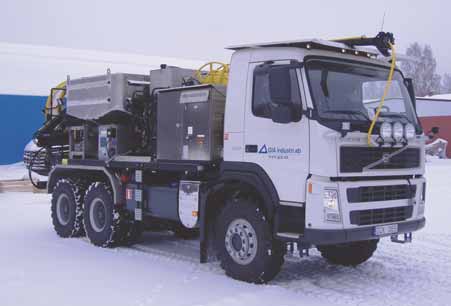
The Shuttlecar consists of up to eight cars with bottom conveyors which provide loading from car to car and the quickest car loading system on the market. In addition, it allows continuous loading of rail cars without the need for switches or time-consuming shunting. The third element of the high-speed system is the well known GIA locomotive.
Another successful product is the GIA SwedVent high pressure mining and tunneling ventilation fan. Available in diameters of 630–2,240 mm with airflows from 2–200 m2/s, the heavy-duty fans feature guide vanes and adjustable blade angles as standard. The fans form part of a complete system that includes flexible ducting, bends, branches and reducers. These are made from PVCcoated polyester fabric, developed specifically for use in underground applications. The ducting is available in diameters from 400–3,000 mm in unit lengths of 10–100 m. For many projects, GIA designs and calculates the total ventilation system to give the lowest total ventilation cost.
As well as the scaling truck the GIA product range includes platforms plus the Mechanized Cable Insertion System (MEGCIS) for rock stabilization. The MEGCIS unit inserts steel cable and grout into pre-drilled holes up to 40 m deep to stabilize tunnel roofs or hanging walls. Rounding off the product range are items such as rescue chambers and hand tools for miners.
In addition to offering the RBO personnel carrier and the Charmec range of explosives charging vehicles mentioned in May, Normet is a major player in the mining and tunneling shotcrete spraying vehicle markets. At bauma, Normet introduced the Spraymec 7110 WPC, now the most advanced model in the Spraymec series (E&MJ, April 2007, p. 56). Spraymec 7110 WPC is a versatile machine for medium size tunnels with variable cross sections. It reaches roof heights of over 11 m but can also be applied to efficient spraying in tunnels with only a 12-m2 cross-section. Both Charmec and Spraymec machines can be remote controlled for greater safety, using either cable or radio signals.
The Charmec range now includes the Charmec 2000BEA, a combination charging vehicle for large profiles. Either of the two charging baskets fitted on the 2000BEA can charge emulsion or ANFO explosives and both types can be charged simultaneously at a face. The vehicle is equipped with one 2,500-kg emulsion matrix tank and two 1,000-kg ANFO tanks. Utilizing emulsion in the contour holes and ANFO in the cut holes reduces explosive costs and the Charmec saves charging time.
Heavy Duty Engines, Trucks and More
The Cummins engines utilized in Atlas
Copco’s Scooptrams and Minetrucks
aren’t the only Tier 3 compliant engines
available: Sweden’s two leading truck
manufacturers, Scania and the Volvo
group, are two of the alternative suppliers
in certain size classes and these
engines are available not only for vehicles
produced in-group but also for
industrial markets such as power generating
and marine applications (E&MJ,
April 2007, pp. 78, 83). For example,
Scania Industrial & Marine Engines can
now offer a complete range of industrial
engines consisting of 9-, 12- and 16-
litre engines that comply with emission
legislations Stage IIIA and Tier 3.
Although designed for normal road use, both manufacturers’ trucks are used in open-pit and underground mine applications for rock and ore haulage and for explosives delivery. However, Volvo Construction Equipment (Volvo CE) uses Volvo engines and power train elements in a wide range of specialized off-road equipment, including articulated dump trucks (ADTs). Volvo Powertrain recently announced 50% and 20% capacity increases at, respectively, its Köping and Skovde factories in Sweden (E&MJ, July/August 2007, p. 76).
At bauma Volvo CE displayed a radically redesigned range of articulated dump trucks, the E-Series, featuring a new “Full Suspension” system. The new A35E and A40E models are the world’s first to offer the FS suspension with automatic leveling and stability control on all wheels, allowing the hauler to travel at much higher speeds and increasing productivity. Instead of the traditional rubber suspension, there is a hydraulic cylinder fitted to each wheel. The system constantly monitors the load and ground conditions; adapting the suspension to suit the prevailing conditions and giving a smooth and stable ride. Even when fully loaded, the ESeries haulers’ ability to “float” over rough ground without bouncing and rolling also improves operator comfort and safety. It is now possible for a hauler to travel at 55 km/h over rough haul roads with minimal bouncing rolling or shaking, the manufacturer claims. The E-Series does not abandon traditional suspensions however, Volvo CE continues to offer all models with upgraded versions of the current suspension arrangement.
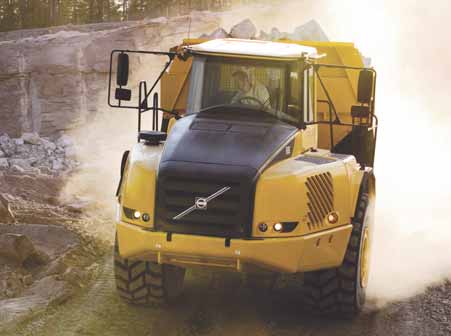
The other bauma launch of particular interest to the mining industry was Volvo CE’s largest yet wheel loader, the L350F (E&MJ, July/August 2007, p. 82). The other Nordic manufacturer of articulated dump trucks, and also wellestablished, is the Norwegian company Moxy Engineering. At bauma, Moxy launched a new large model with a capacity of 46.3 mt designed to compete with the B50 from Bell Equipment. Moxy claims its MT51 has the edge in terms of payload, being the biggest ADT on the market right now and offering a cost per ton advantage over smaller machines. The characteristic Moxy sloping chassis and bowlshaped body have been retained and so has rear gear six-wheel drive system. The MT51 has a Cummins QSX15 diesel driving through an Allison transmission system. Wet plate discs are fitted at the rear ensuring that the machine will stop as well as it goes. Brake cooling is achieved by circulating the oil through the large rear gear drive casings.
In late August, Moxy announced plans to enter the rigid dump truck market by utilizing the intellectual property rights to the Aveling-Barford rigid dump truck range, which the Norwegian company has acquired. Moxy also has the right to use the famous Invicta logo. The Aveling- Barford brand hasn’t been a big seller for some time but the unique design did have its devotees. The first Moxy rigid truck is scheduled to launch in summer 2008.
Developed from Aveling-Barford’s RD44 model, the new AB51 will be powered by a Cummins QSX15 diesel engine producing 447 kW at 2,100 rpm, driving through a six-speed Allison H5600AR transmission with six forward and two reverse gears. The rear Kessler driving axle will feature inboard planetary reduction gears in both hubs, and oil-immersed brakes will be fitted on the rear axle with dry disc type brakes on the front. Front and rear tire sizes will be the same with 2,100 x 35 tubeless tires fitted all round. With an overall length of 8.3 m, a maximum width of 4.25 m, a loading height of 3.3 m and a wheelbase of 3.93 m, the truck will weigh 77.6 mt and offer a 46.3-mt payload. Made from abrasion-resistant steel and mounted on special supports to absorb shock loads and vibration, the rear tipping body will have a heaped capacity of 28.8m3, while the twocylinder, two-stage hoist system, fixed to the chassis and powered by a pump directly mounted to the gearbox, will give a tipping time of less than 11sec to a maximum angle of 51°.
A major feature of the AB51 will be its new, heavy-duty, sound-proofed cab, which Moxy said will offer significant improvements over the one fitted to the truck’s RD44 predecessor. Mounted on special supports to reduce vibration, the cab will benefit from a pneumatic suspension seat and airconditioning as standard, and all engine and component functions will be covered by a comprehensive instrumentation panel.
Commenting on the new dump truck, Jamie Thomson, Moxy Engineering’s managing director, said plans were also in the pipeline to introduce further models in the future. “The AB51 will be followed by the AB76, a significantly updated version of the Aveling-Barford RD65. Also planned is a 100-mt-capacity model, which will be an entirely new design,” he said. Moxy plans to build the new rigid trucks alongside their ADTs at the company’s manufacturing facility in Elnesvagen, Norway, subject to permission to move the trucks by road to the docks.
Flexit Serves LKAB’s Needs…
Flexit, based in Vallentuna, Sweden,
has reported success at LKAB. During
fall 2006, in need of a survey tool that
is not affected by magnetism, the iron
ore miner tested the Flexit GyroSmart
and other non-magnetic survey systems.
The GyroSmart was chosen,
Flexit said, because it produced higher
quality data and was easier to use overall
than competing products. LKAB
should be in a good position to judge:
the company has used borehole deviation
tools in magnetite for more than
30 years.
Shortly after announcing this sale, Flexit presented results achieved with GyroSmart at a spread of operations to the PDAC/CAMESE Exhibitors’ Innovation Forum at PDAC 2007 in Toronto.
…and LKAB Serves the Industry
One of the LKAB Group’s four operating
units is the Special Businesses Division
(SBD). Mainly the division supports
LKAB’s own companies with services
and technical development work but
the SBD also does business with other
mining companies and with construction
and civil engineering firms. The
division employed 178 people in 2006
and the operating margin was 16.3%.
In rock excavation, LKAB has played a well-documented role in the development of water-powered rock drills. During 2006, the group acquired Sandvik’s 40% stake in Wassara AB, the firm that builds the Wassara drilling systems. Although the joint venture company had enjoyed some success in selling the Wassara ITH rock drill and accessories to both mining and construction companies (E&MJ, December 2006, p.50) LKAB intends to increase marketing efforts, stressing the environmental advantages of water-drive, with the aim of doubling sales within three years. Meanwhile Sandvik is developing a new automated Solo drilling rig for LKAB that will use the Wassara drill (E&MJ, May 2007, pp 77-78).
KGS (AB Kiruna Grus- och Stenförädling) upgrades some of LKAB’s waste rock to road and concrete ballast, blasts, crushes and hauls mineral products and provides shotcreting services to the Mining Division, including concrete production. Concrete delivery volume increased by 110% in 2006, requiring the re-opening of one of the firm’s three concrete stations. Demand for shotcreting increased by 58%, mainly as a result of additional deliveries to the contractor NCC. KGS plans to take advantage of increased demand to also market its shotcreting service to other mines, civil engineering and tunneling enterprises.
The KGS subsidiary Kimit supplies explosives to LKAB and other companies in the Nordic market. In 2006, production increased by 4.5% and the firm signed supply agreements covering deliveries to central Sweden and, with Lapua, in Finland. Another subsidiary, KGS Mekaniska, does mechanical engineering work and is part of a consortium building rail wagons for LKAB.